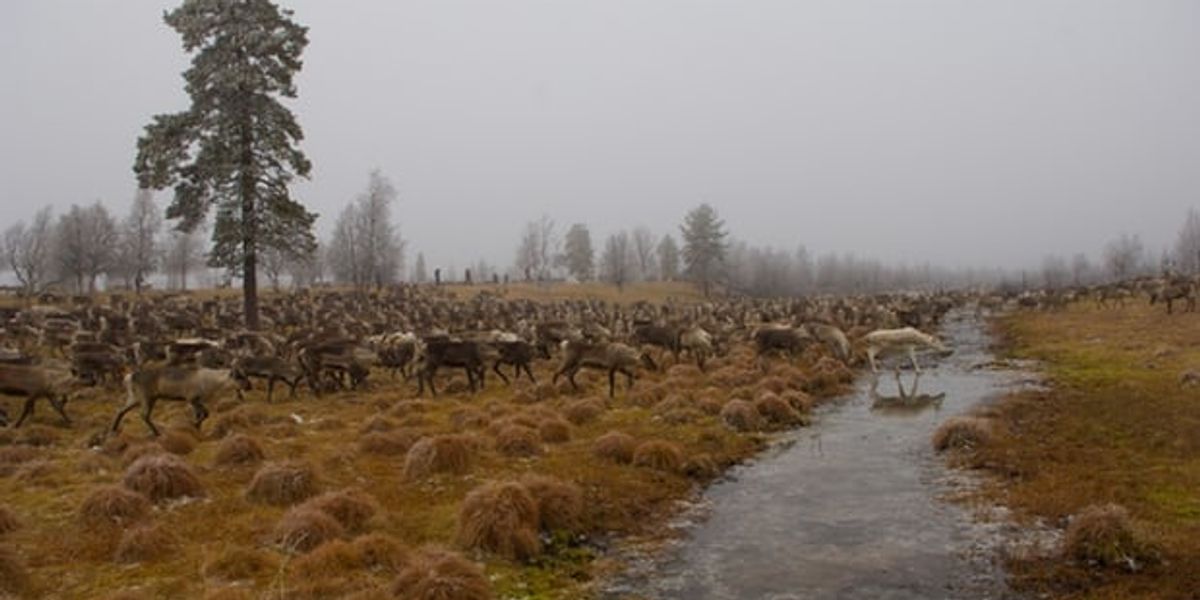
24 May 2018
'We can't see a future': group takes EU to court over climate change
Litigants from eight countries claim EU institutions are not protecting fundamental rights.

Litigants from eight countries claim EU institutions are not protecting fundamental rights.

Farmers of color who are leading the charge for regenerative farming, as they have done for generations, need our support now more than ever.
As summer heats up, we all find ourselves wondering, how hot will this one be?
Several of the last summers have been the hottest summers on record. For farmers, who depend on clement weather for their livelihoods and to feed our communities, a sudden heatwave or an erratic downpour amplified by climate change can cause real harm to livelihoods. Often, it’s not easy to ‘bounce back’ or finance repairs to damaged farms.
Last summer, Ashanti, a farmer in upstate New York, experienced severe flooding from a nearby stream that immersed half of her growing field in water. She managed to salvage some of her crop by using a high tunnel (a plastic-covered structure that extends the growing season), but the flooding delayed her farmer’s market sales and food pantry deliveries, causing Ashanti to lose income needed for daily business expenses. While some towns are now implementing early response systems for extreme weather, none were in place to mitigate the damage to Ashanti’s farm.
For most farmers, climate change is not a future problem, but a daily challenge. This is especially true for Black farmers like Ashanti, as well as Indigenous and other farmers of color who are particularly vulnerable due to well documented discrimination by the USDA and by banking institutions. When climate disasters hit, these systemic challenges have prevented many such farmers from receiving loans to pay for repairs to damaged farms, or from owning land, as opposed to leasing it.
As advocates for farmers with the HEAL Food Alliance and Northeast Farmers of Color Land Trust, we’ve seen firsthand how farmers of color struggle to deal with climate challenges amid a systemic lack of resources and the impacts of structural racism. Our organizations have worked with dozens of farmers who steward their land, but lack access to the capital they need to adapt to climate change or to secure the long term land tenure stability that makes investment in climate adaptations more feasible. Community leaders have warned of this need for years, but opportunities for federal action have been limited – until now.
Amid growing opposition to clean energy and climate resilience investments, an unexpected avenue for climate justice has emerged – the Farm Bill, an over $400 billion legislative package that funds key federal programs and shapes our country’s food and agricultural policy. This year, Congress has the opportunity to make a historic investment in regenerative farming practices that would meaningfully reduce emissions that come from agriculture and provide real relief to farmers of color.
For example, in the so-called ‘Black Dirt’ region of Orange County, New York, known for its fertile black soil, Latine and Black farmers are pushing for meaningful investments in regenerative agricultural practices and climate resilience programs that protect the land and food security. Many of these farmers don’t own the land that they work - and if they do, they are recent land owners. Because they lack land security, spending their own capital on large scale infrastructure is a huge risk. So several dozen farmers of color from the area have asked for funding assistance with drainage for over a year without success. Funding to add more climate-resilient ditches to their farms would help them withstand flooding and also protect other nearby farms. But as both lessees and more recent owners of their farmland, they have less local political clout than landowning constituents and are more likely than long-standing landowners to face barriers to adopting new farming strategies. To support these farmers and others across the country who are burdened by climate change, the next Farm Bill could expand resources to support farming practices that protect and restore soil health. Healthy soils are more likely to bounce back from flooding and other adverse impacts of climate chaos. In addition to supporting local food economies, these practices can reduce emissions and other toxic pollutants, and revitalize ecosystems.
Amid growing opposition to clean energy and climate resilience investments, an unexpected avenue for climate justice has emerged – the Farm Bill.
Black, Indigenous, and other land stewards of color have long used regenerative farming methods rooted in traditional ecological knowledge. For example, the Diné people of the Navajo Nation have practiced alluvial farming, or planting crops in soil that has formed from sediment deposits, for hundreds of years. This maximizes the nutrients and water that crops receive - without depending on chemical fertilizers or pesticides. Indigenous and immigrant farmers of color have innovated new approaches like these that are rooted in cultural traditions of respect for the land, water, seeds, and life that sustain us. They’ve done so even while confronting seizure of their land, theft of their labor, harm from industrial agriculture, and contamination of their land and water.
These farmers know that investing in regenerative farming can ensure climate resilience and protect local economies. The Farm Bill is among our best chances to make this a reality. By establishing protections and meaningful supports for farmers who are most vulnerable to climate change, the Farm Bill can propel us toward our climate goals while allowing farmers of color to adapt to new uncertainties that climate change has created.
In May, the Senate released a long-delayed Farm Bill proposal while the House released their draft of text for the 2024 Bill. We were happy to see that the Senate proposal includes traditional ecological knowledge as a part of conservation and climate programs, and includes provisions for the protection of Inflation Reduction Act (IRA) funds for conservation and climate spending. This is a step in the right direction for our nation's farmers, and for our environment.
Unfortunately, we see the exact opposite in the House Agriculture Committee’s Farm Bill draft, which does little to address farmers’ concerns about climate change. In fact, the Bill moves us backwards. The House Bill removes climate-related safeguards in conservation programs stipulated by the Inflation Reduction Act, which was passed in 2022 and provided historic investments for fighting climate change. To be clear, the 2024 Farm Bill must be a climate bill. Removing support for climate-related programs and practices will not only further disadvantage farmers who are investing in regenerative agriculture and traditional ecological knowledge to build resilience in their operations, but wreak havoc on the nation’s food security.
As climate extremes worsen, the architects of this Farm Bill must change their strategy if they hope for the survival of farmers, communities, or our economies. Farmers of color who are leading the charge for regenerative farming, as they have done for generations, need our support now more than ever, and deserve a farm bill that puts climate front and center.
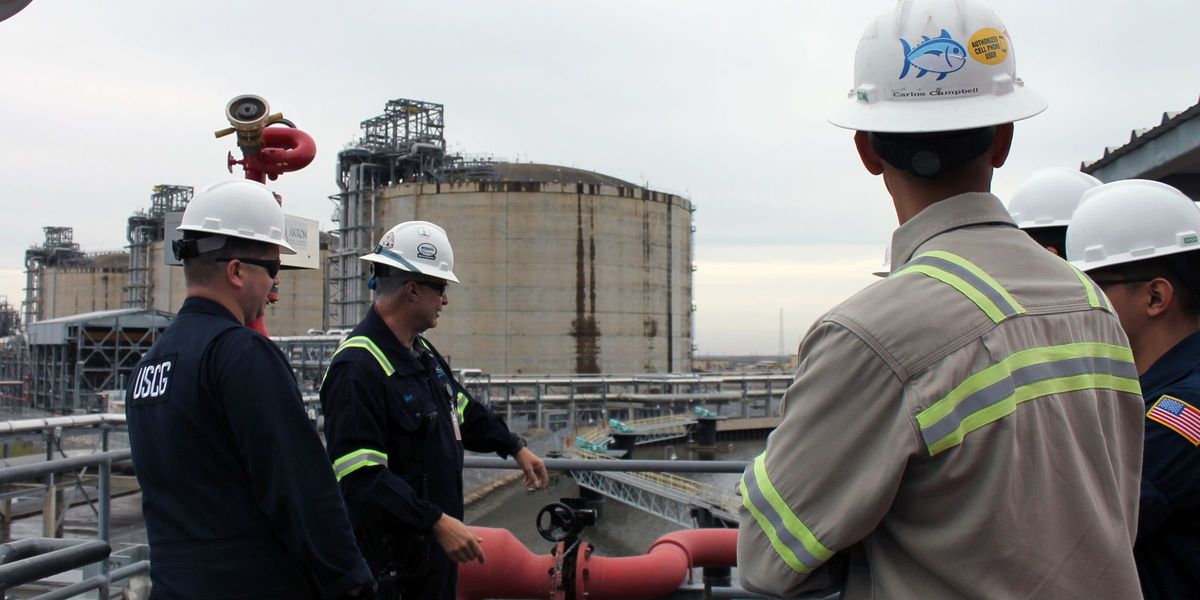
CAMERON PARISH, La. — Late into the night, John Allaire watches the facility next to his home shoot 300-foot flares from stacks.
He lives within eyesight of southwest Louisiana’s salty shores, where, for decades, he’s witnessed nearly 200 feet of land between it and his property line disappear into the sea. Two-thirds of the land was rebuilt to aid the oil and gas industry’s LNG expansion. LNG — shorthand for liquified natural gas – is natural gas that's cooled to liquid form for easier storage or transport; it equates to 1/600th the volume of natural gas in a gaseous state. It’s used to generate electricity, or fuel stove tops and home heaters, and in industrial processes like manufacturing fertilizer.
In the U.S., at least 30 new LNG terminal facilities have been constructed or proposed since 2016, according to the Oil and Gas Watch project. Louisiana and Texas’ Gulf Coast, where five facilities are already operating, will host roughly two-thirds of the new LNG terminals – meaning at least 22 Gulf Coast LNG facilities are currently under construction, were recently approved to break ground or are under further regulatory review.
Although the U.S. didn’t ship LNG until 2016, when a freight tanker left, a few miles from where Cameron Parish’s LNG plants are today, last year the country became the global leader in LNG production and export volume, leapfrogging exporters like Qatar and Australia. The EIA’s most recent annual outlook estimated that between the current year and 2050, U.S. LNG exports will increase by 152%.
And it’s changed local economic estimates: last year, retired Louisiana State University professor Loren Scott’s economic forecast last year predicted an additional $36 billion in oil and gas industry spending will boost local employment by 7% over just two years.
Allaire, 68, watches how saltwater collects where rainwater once fed the area’s diminishing coastal wetlands. “We still come down here with the kids and set out the fishing rods. It's not as nice as it used to be,” he told Environmental Health News (EHN).
That intimacy with nature drew Allaire to the area when he purchased 311 acres in 1998. An environmental engineer and 30-year oil and gas industry veteran, he helped lead environmental assessments and manage clean-ups, and although retired, he still works part-time as an environmental consultant with major petroleum companies. With a lifetime of oil and gas industry expertise, he’s watched the industry's footprint spread across Louisiana and the Gulf of Mexico’s fragile shores and beyond. Now that the footprints are at the edge of his backyard, Allaire is among a cohort of organizers, residents and fisher-folk in the region mobilizing to stop LNG facility construction. For him, the industry’s expansion usurps the right-or-wrong ethics he carried across his consulting career. For anglers, oil and gas infrastructure has destroyed fishing grounds and prevented smaller vessels from accessing the seafood-rich waters of the Calcasieu River.
From the view of Allaire’s white pickup truck as he drives across his property to the ocean’s shore, he points to where a new LNG facility will replace marshlands. Commonwealth LNG intends to clear the land of trees and then backfill the remaining low-lying field.
“You see what’s happening with the environment,” Allaire said. “When the facts change, I got to change my mind about what we’re doing.”
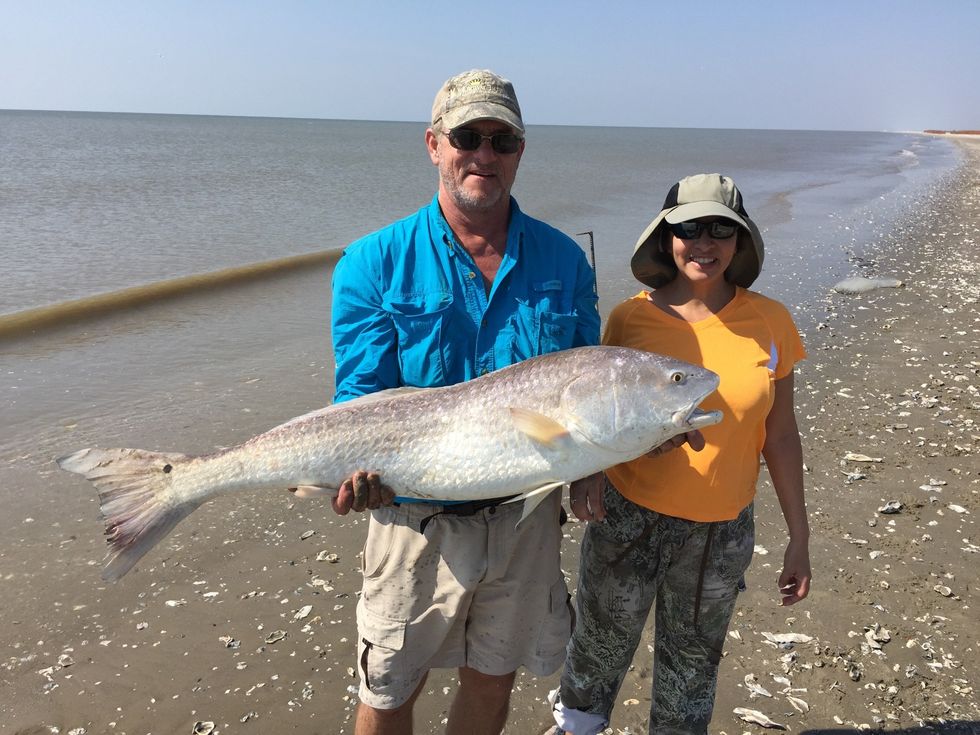
John Allaire, left, purchased 311 acres in Cameron Parish in 1998, and has watched the oil and gas industry's footprint spread to his property.
Credit: John Allaire
During an Earth Day rally in April, community members gathered in the urban center of Lake Charles to demand local oil and gas industries help deliver a safer, healthier future for all. In between live acts by artists performing south Louisiana’s quintessential zydeco musical style, speakers like James Hiatt, a Calcasieu Parish native with ties to Cameron Parish and a Healthy Gulf organizer, and RISE St. James organizer Sharon Lavigne, who’s fighting against LNG development in rural Plaquemines Parish near the city of New Orleans, asked the nearly 100 in attendance to imagine a day in which the skyline isn’t dotted by oil and gas infrastructure.
Not long ago, it was hard to imagine an Earth Day rally in southwest Louisiana at all. For decades, the area has been decorated with fossil fuel infrastructure. Sunsets on some days are highlighted by the chemicals in the air; at night, thousands of facilities’ lights dot the dark sky.
“It takes a lot of balls for people to start speaking up,” Shreyas Vasudevan, a campaign researcher with the Louisiana Bucket Brigade, told EHN in the days after the rally. In a region with its history and economy intertwined with oil and gas production, “you can get a lot of social criticism – or ostracization, as well – even threats to your life.”
Many are involved in local, regional and national advocacy groups, including the Louisiana Bucket Brigade, Healthy Gulf, the Sierra Club, the Natural Resources Defense Council, the Turtle Island Restoration Network, the Center for Biological Diversity and the National Audubon Society.
But environmental organizers are fighting a multi-billion-dollar industry with federal and state winds at its back. And LNG’s federal support is coupled with existing state initiatives.
Under outgoing Louisiana Gov. John Bel Edwards — a term-limited Democrat — the state pledged a goal of reaching net-zero greenhouse emissions by 2050. Natural gas, which the LNG industry markets as a cleaner-burning alternative, is cited as one of the state’s solutions. Louisiana is the only state that produces a majority of its carbon emissions through fossil fuels refining industries, like LNG, rather than energy production or transportation. Governor Edwards’ office did not return EHN’s request for comment.
This accommodating attitude towards oil and gas industries has resulted in a workforce that’s trained to work in LNG refining facilities across much of the rural Gulf region, said Steven Miles, a lawyer at Baker Botts LLP and a fellow at the Baker Institute’s Center on Energy Studies. Simultaneously, anti-industrialization pushback is lacking. It’s good news for industries like LNG.
“The bad news,” Miles added. “[LNG facilities] are all being jammed in the same areas.”
One rallying cry for opponents is local health. The Environmental Integrity Project found that LNG export terminals emit chemicals like carbon monoxide –potentially deadly– and sulfur dioxide, of which the American Lung Association says long-term exposure can lead to heart disease, cancer, and damage to internal or female reproductive organs.
An analysis of emissions monitoring reports by the advocacy group the Louisiana Bucket Brigade found that Venture Global’s existing Calcasieu Pass facility had more than 2,000 permit violations.That includes exceeding the permit’s authorized air emissions limit to release nitrogen oxides, carbon monoxide, particulate matter and volatile organic compounds 286 out of its first 343 days of operation.

The Marvel Crane, the first liquid natural gas carrier to transport natural gas from the Southwest Louisiana LNG facility, transits a channel in Hackberry, Louisiana, May 28, 2019.
Credit: Coast Guard News
Rather than amend its infrastructure to meet regulatory standards, Venture Global is asking the state to raise its facility’s air emissions permit limits to release an additional 833% of greenhouses gasses each year, according to the Louisiana Bucket Brigade’s January report. If approved, permitted emissions would rise to roughly 4.65 million tons, making the facility the state’s fifth-largest emitter), according to a 2021 statewide greenhouse data inventory compiled by Louisiana State University’s Center for Energy Studies.
“This is just one facility,” at a time when three more facilities have been proposed in the region and state, Vasudevan said. Venture Global’s operational LNG facility — also known as Calcasieu Pass — “is much smaller than the other facility they’ve proposed.”
In an area that experienced 18 feet of storm surge during Hurricane Laura in 2020 — and just weeks later, struck by Hurricane Delta — Venture Global is planning to build a second export terminal Known as “CP2,” it’s the largest of the roughly two dozen proposed Gulf LNG export terminals, and a key focal point for the region’s local organizing effort.
Residents “don’t really want LNG as much as they want Cameron [Parish] from 1990 back,” Hiatt told EHN of locals’ nostalgia for a community before storms like Rita in 2005 brought up to 15 feet of storm surge, only for Laura to repeat the damage in 2020. Throughout that time, the parish’s population dipped from roughly 10,000 to 5,000. “But the wolf knocking at the door is LNG. Folks in Cameron think that's going to bring back community, bring back the schools, bring back this time before we had all these storms — when Cameron was pretty prosperous.”
“Clearly,” for the oil and gas industry, “the idea is to transform what was once the center of commercial fishing in Louisiana to gas exports,” Cindy Robertson, an environmental activist in southwest Louisiana, told EHN.
Helping fishers’ impacted by LNG is about “actual survival of this unique culture,” Cooke said.
In a measure of organizers’ success, she pointed to a recent permit hearing for Venture Global’s CP2 proposal. Regionally, it’s the only project that’s received an environmental permit, but not its export permit, which remains under federal review. At the meeting, some spoke on the company’s behalf. As an organizer, it was a moment of clarity, Cooke explained. Venture Global officials “had obviously done a lot of coaching and organizing and getting people together in Cameron to speak out on their behalf,” Cooke said. “So, in a way, that was bad. But in another way, it shows that we really had an impact.”
“It also shows that we have a lot to do,” Cooke added.
Environmental organizers like Alyssa Portaro describe a sense of fortitude among activists — she and her husband to the region’s nearby town of Vinton near the Texas-Louisiana border. Since the families’ relocation to their farm, Portaro has worked with Cameron Parish fisher-folk.
“I’ve not witnessed ‘community’ anywhere like there is in Louisiana,” Portaro told EHN. But a New Jersey native, she understands the toll environmental pollution has on low-income communities. “This environment, it’s so at risk — and it’s currently getting sacrificed to big industries.”
“People don’t know what we’d do without oil and gas. It comes at a big price,” she added.
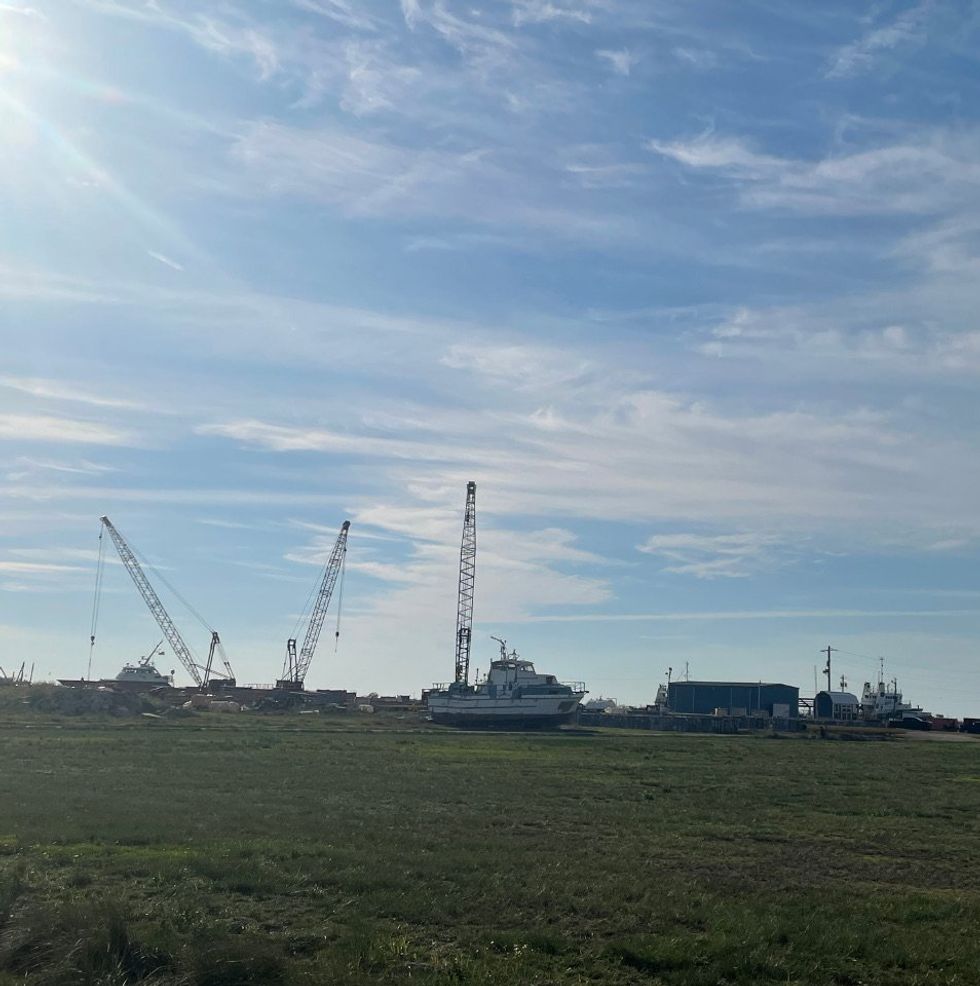
Southwest Louisiana’s Cameron Parish is one of the state’s most rural localities. Marine economies were the area’s economic drivers until natural disasters and LNG facilities began pushing locals out, commercial fishers claim.
Credit: Xander Peters for Environmental Health News
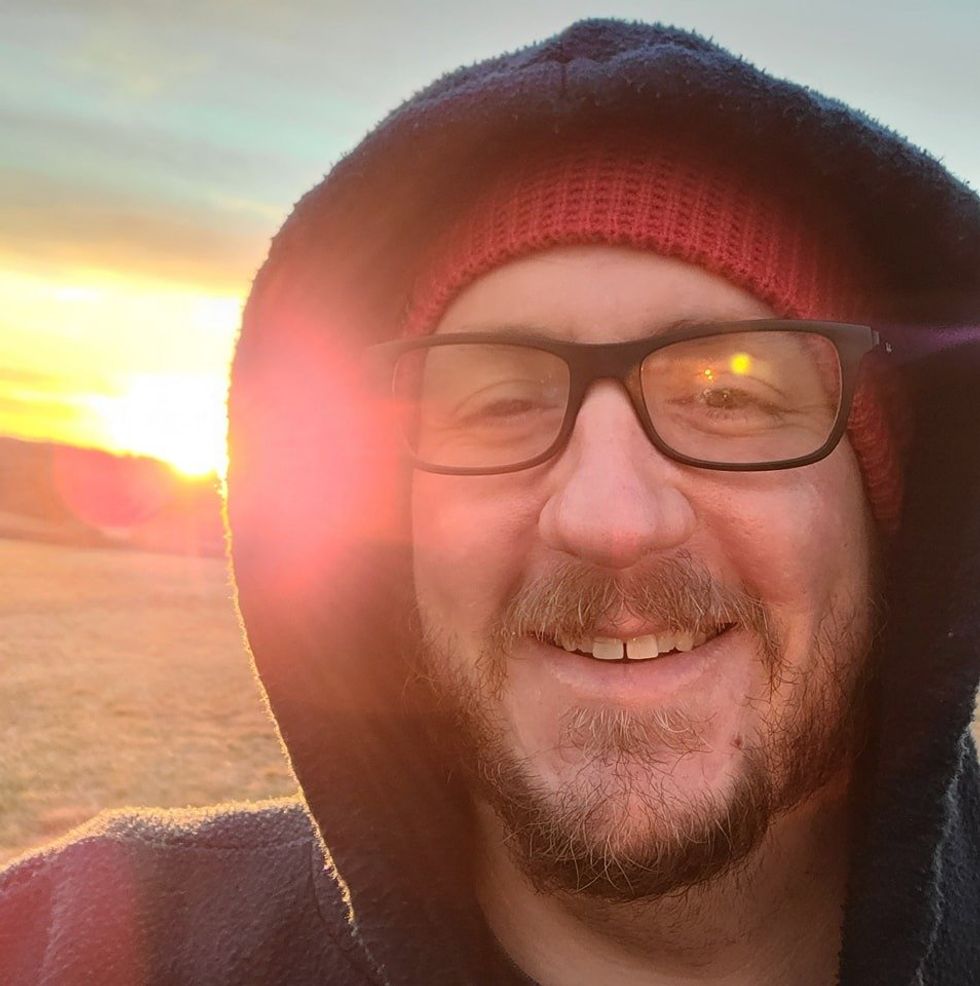
Residents “don’t really want LNG as much as they want Cameron [Parish] from 1990 back,” James Hiatt , a Healthy Gulf organizer, told EHN. "But the wolf knocking at the door is LNG."
Credit: Xander Peters for Environmental Health News
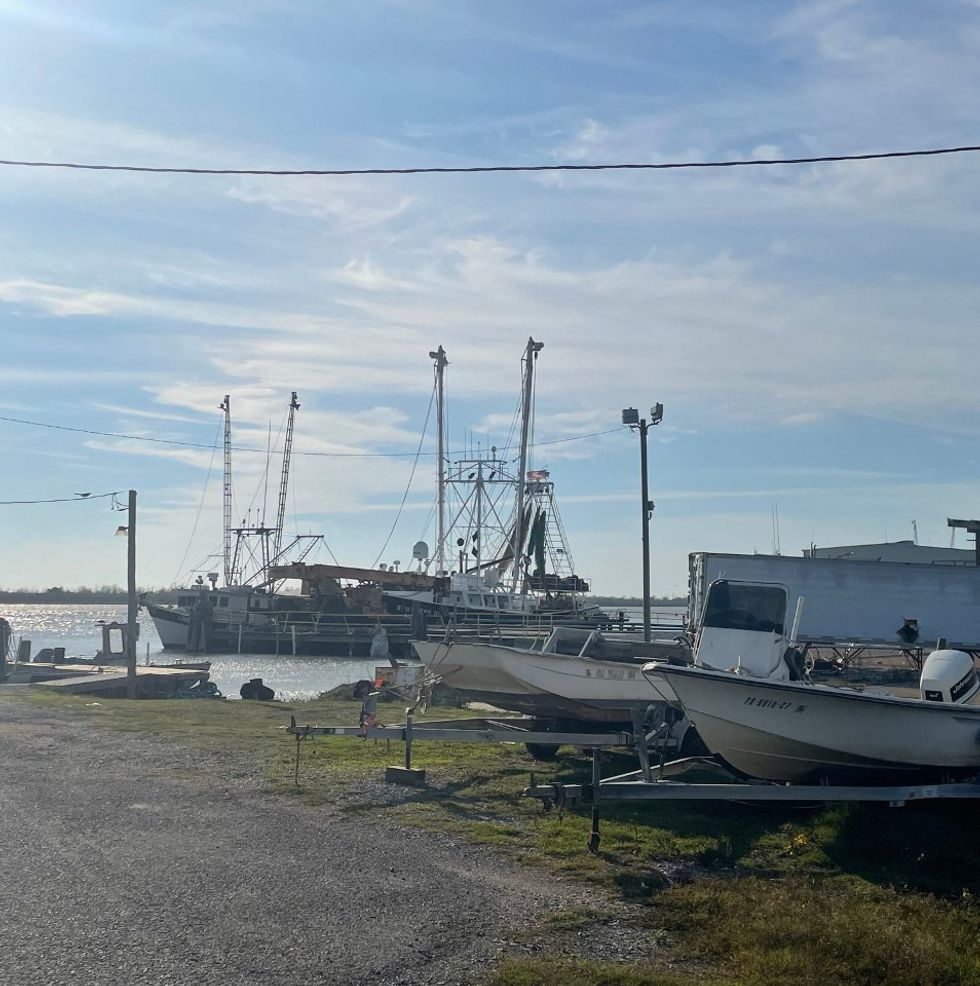
For the most part, Cameron Parish’s life and economy has historically taken place at sea. As new LNG facilities are operational or in planning locally, locals claim the community they once knew is nearly unrecognizable.
Credit: Xander Peters for Environmental Health News
The stakes are seemingly higher for a region like southwest Louisiana, which is the epicenter of climate change impacts.
In nearly a century, the state has lost roughly 2,000 square miles of land to coastal erosion. In part driving the state’s erosion crisis is the compounding impacts of Mississippi River infrastructure and oil and gas industry activity, such as dredging canals for shipping purposes, according to a March study published in the journal Nature Sustainability. Louisiana’s Coastal Protection and Restoration Authority said Cameron Parish could lose more land than other coastal parishes over the next 50 years. A recent Climate Central report says the parish will be underwater within that time frame.
On top of erosion and sea level rise impacts, in August, 2023, marshland across southwest Louisiana’s Cameron Parish burned. The fires were among at least 600 across the Bayou State this year. Statewide, roughly 60,000 acres burned — a more than six-fold increase of the state’s average acres burned per year in the past decade alone.
But while the blaze avoided coastal Louisiana communities like Cameron Parish, the fires represented a warning coming from a growing chorus of locals across the region — one that’s echoes by the local commercial fishing population, who claimed to have experienced unusually low yields during the same time, according to a statement from a local environmental group. At the site of the Cameron Parish fires are locations for two proposed LNG expansion projects.
It was an unusual occurrence for an area that’s more often itself underwater this time of year due to a storm surge from powerful storms. For LNG expansion’s local opposition, it was a red flag.
As the Louisiana Bucket Brigade has noted prior, the confluence of climate change’s raising of sea levels and the construction of LNG export terminals — some are proposed at the size of nearly 700 football fields — are wiping away the marshland folks like Allaire watched wither. Among their fears is that the future facilities won’t be able to withstand the power of another storm like Laura and its storm surge, which wiped away entire communities in 2020.
Amidst these regional climate impacts, LNG infrastructure has shown potential to exacerbate the accumulation of greenhouse gasses that cause global warming. For the most part, LNG is made up of methane — a greenhouse gas that’s more than 80 times more potent than carbon dioxide in the atmosphere. Among the 22 current LNG facility proposals, the advocacy group Sierra Club described a combined climate pollution output that would roughly equal to that of about 440 coal plants.
The climate impacts prompt some of the LNG industry’s uncertainty going forward. It isn’t clear if Asian countries, key importers of U.S. LNG, will “embrace these energy transition issues,” said David Dismuke, an energy consultant and the former executive director of Louisiana State University’s Center for Energy Studies. Likewise, European nations remain skeptical of embracing LNG as a future staple fuel source.
“They really don't want to have to pull the trigger,” Dismukes added, referring to Europe’s hesitation to commit more resources to exporting LNG from the American market. “They don't want to go down that road.”
While there will be a tapering down of natural gas supply, Miles explained, “we’re going to need natural gas for a long time,” as larger battery storage for renewables is still unavailable.
“I'm not one of these futurists that can tell you where we're going to be, but I just don't see everything being extreme,” Dismukes said. “I don't see what we've already built getting stranded and going away, either.”
For now, LNG seems here to stay. From 2012 to 2022,U.S. natural gas demand — the sum of both domestic consumption and gross exports — rose by a whopping 43%, reported the U.S. Energy Information Administration, or EIA. Meanwhile, in oil and gas hotbeds like Louisiana and Texas, natural gas demand grew by 116%.
Throughout 25 years, Allaire has witnessed southwest Louisiana’s land slowly fade, in part driven by the same industrial spread regionally. Near where the front door of his travel trailer sits underneath the aluminum awning, he points to a chenier ridge located near the end of the property. It’s disappearing, he said.
“See the sand washing over, in here?” Allaire says, as he points towards the stretches of his property. “This pond used to go down for a half mile. This is all that's left of it on this side.”
Read Part 1: LNG production comes with a price, Gulf Coast communities warn
Some funding for this reporting was also provided by the Wake Forest University Environmental and Epistemic Justice Initiative.

When Hurricane Beryl struck Houston, it revealed significant weaknesses in the city's ability to withstand even a mild hurricane, leaving millions without power.
In short:
Key quote:
"A Cat 1 hurricane shouldn’t knock out your power system. I think you’ve got a problem with the power company, frankly."
— Kerry Emanuel, veteran hurricane researcher and professor emeritus at the Massachusetts Institute for Technology
Why this matters:
Houston's experience with Hurricane Beryl emphasizes the need to improve infrastructure to handle stronger storms. As climate change intensifies, such preparedness is vital to protect lives and property.

Former Trump officials, including senior energy and environmental appointees, have created Project 2025, a policy blueprint for a potential second term, despite Trump claiming no knowledge of it.
In short:
Key quote:
“It’s not meant to be a blueprint for Donald Trump — it’s meant to be a blueprint for a conservative president.”
— Stephen Moore, Project 2025 co-author
Why this matters:
Project 2025 could influence future conservative administrations, potentially leading to major shifts in U.S. energy and environmental policies. The debate around this blueprint highlights the political divide over environmental regulation and climate change strategies.

A group of Democratic lawmakers is investigating if shale oil companies colluded to manipulate oil prices, potentially affecting their federal land leases and operations.
In short:
Key quote:
“If a company is found guilty of something like collusion, we have regulations in place that make them ineligible to hold a lease in the future.”
— Liz Klein, Bureau of Ocean Energy Management Director
Why this matters:
Collusion among shale producers could artificially inflate oil prices, burdening consumers and violating antitrust laws. Regulatory actions against these companies could disrupt their operations and impact their financial stability.
Related EHN coverage:

Rising temperatures and wildfires fueled by climate change are posing significant health risks across Canada, with humid conditions exacerbating the effects.
In short:
Key quote:
"Some people may not be in the habit of protecting themselves from heat, given that this is early in the season. It’s still really important to prepare, particularly for people that may require assistance."
— Peter Berry, Health Canada spokesperson
Why this matters:
Rising temperatures and increased frequency of heat domes, driven by climate change, heighten the health risks of extreme heat and poor air quality.

The Paris Olympics promises minimal new construction, using the city's iconic landmarks to create sustainable and visually stunning venues for the Games.
In short:
Key quote:
“We have transformed public spaces, public transport, the river – without the Games, it could have taken a decade or two more.”
— Emmanuel Grégoire, former Paris deputy mayor for urban planning
Why this matters:
Ultimately, the success of Paris 2024 will be judged not only by the medals won and records broken but also by its ability to pioneer a new era of environmentally responsible global events. Paris’s ability to balance grandeur with green principles could set a new benchmark for future Olympics and other international gatherings. Read more: Life after carbon: The next global transformation of cities.
Food waste statistics are moving in the wrong direction.
As mounds of dredged material from the Houston Ship Channel dot their neighborhoods, residents are left without answers as to what dangers could be lurking.
“It’s a little ironic that they’re coming to the U.S. and buying a company facing all the same problems they’re facing in Japan.”
Fulcrum BioFuels’ shuttered “sustainable aviation fuel” plant is the latest facility to run into technical and financial challenges.
Nurses have the experience, motivation and public support to make an important contribution in tackling the climate crises.
"We are sick and tired of being sick and tired."